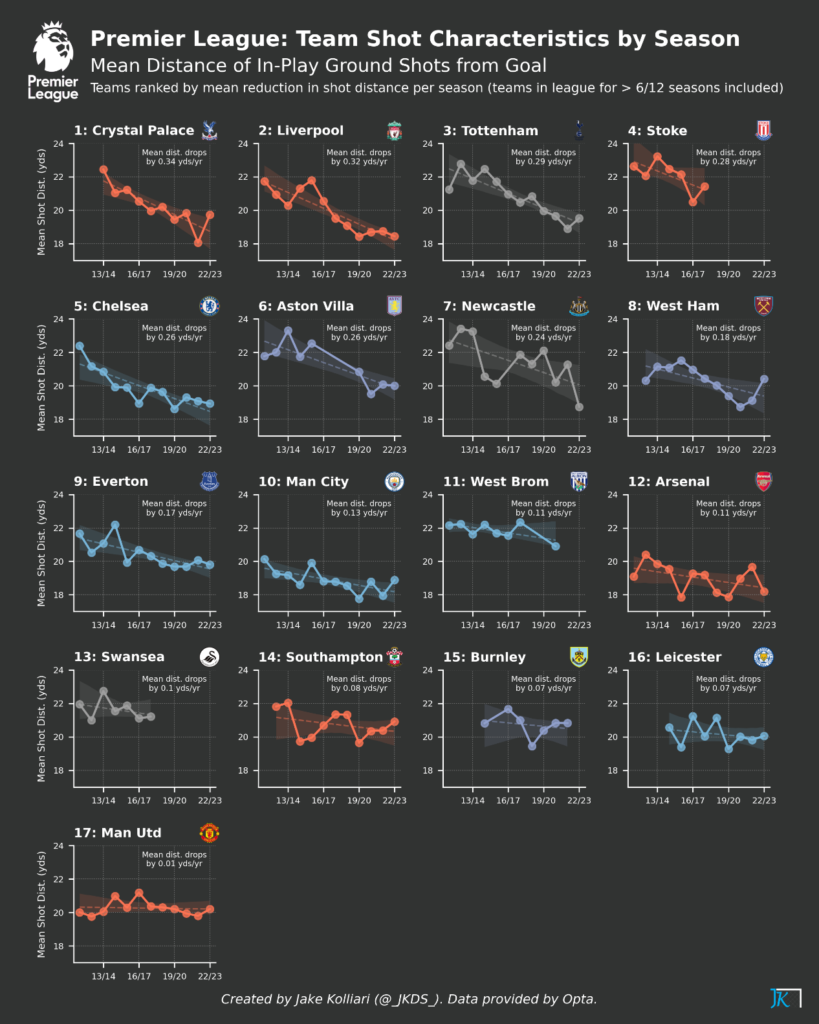A guest contribution written by Jake Kolliari (Twitter: @_JKDS_)
Imagine yourself as the manager of a Premier League football club, and you are asked to define a shooting philosophy for your team. Where would you position your approach on the following scale?

Your choice is most likely based on the option that you believe would result in the highest scoring output. You are effectively trying to find the optimal trade-off between volume of shots and quality of chances, recognising that the quality of chances tends to decrease further from the opposition goal.
The rise of data analytics in the football industry, as well as other tactical influences, has resulted in football clubs considering this trade-off and paying increased attention to their shooting philosophies. This article aims to explore how the art of shooting is changing in football, providing an insight into the evolution of shooting in the Premier League.
Where are shots taken from in the Premier League?
Let’s dive into some analysis and take a look at the positions from which shots have been taken over the past 12 Premier League seasons (2011/12 to 2022/23). Throughout this analysis we:
-
- Remove shots directly from free-kicks and penalties.
-
- Remove headed shots.
This ensures that we are only including situations where the player has actively decided to take a non-headed shot at match-speed.
Looking at the distribution of shots over these seasons (below), one thing is immediately clear: a significant number of shots are taken in and around the centre of the penalty area. However if we shift our attention to shots taken a little further out, it appears as though the volume of shots from range has gradually declined over time; with less shots from range in recent seasons. This is confirmed through calculating the proportion of shots taken outside the box in each season, which has dropped by over 10% across this time period, or by ~1.4% per season.


The decrease in shot distance in the Premier League
Having already seen the significant drop-off in shots taken outside the box in the Premier League, you would expect that the average shot distance has also decreased over time. This is exactly the case – there has been ~2.5 yard reduction in mean shot distance over the past 12 seasons!

So why are teams choosing to move the ball closer to the goal before shooting? Anyone who has kicked a football before knows that, in general, it becomes easier to score as you get closer to the goal. In fact, a quick look at shot conversion rate (% of shots resulting in a goal) throughout each season confirms this (turquoise line). As mean shot distance has decreased over time, the proportion of shots resulting in a goal has increased.
This is no surprise, and it’s the exact type of relationship that underpins the widely discussed expected goals metric!
Why is shot distance decreasing? The data analytics view
Around 2013, the expected goals metric gained popularity and became increasingly used to evaluate the quality of goal-scoring chances. This time frame coincides with the decline in shot distance in the Premier League (and other leagues). Whilst it’s impossible to say with certainty whether or not these two events are directly related, it’s a fascinating correlation to explore and could shed some light on the evolution of tactics and strategy in the modern game.
So what is it about the expected goals metric, or xG, that may have caused teams to re-evaluate where they are taking shots from? The expected goals metric measures the probability of a shot resulting in a goal based on the characteristics of the shot. For example, a shot that is assigned an xG value of 0.1 will result in a goal approximately 10% of the time. Whilst different expected goals models may include or exclude certain factors, it’s clear that shot distance is a crucial component in determining xG values.
Let’s take a closer look. The simple expected goals model below shows the approximate probability of scoring from various areas of the pitch (in-play non-headed shots only). The further you get from the goal, the lower the probability of scoring (xG). Scoring probability within the 6 yard box is often higher than 50%, dropping to 20-30% around the penalty spot, and down to 5-10% on the edge of the box.


Eagle-eyed readers may have observed that the relationship between distance to goal and xG is not linear; as proximity to the goal decreases, the rate of increase in xG becomes steeper. Therefore with each yard a player advances towards the goal, the value of moving the ball just another yard forward before taking the shot becomes greater and greater.
So it wasn’t until 2013 that teams, coaches or analysts were able to quantify the probability of scoring from different areas of the pitch. Equipped with a probabilistic measure for assessing scoring likelihood, it’s possible that players were instructed to take shots from areas on the pitch with a statistically higher chance of scoring. You can imagine a coach telling Andros Townsend that whenever he shoots from 40 yards out, he really only has a 1% chance of scoring!
Consider the following hypothetical situation. You are 30 yards from goal, with a 3% chance of scoring if you shoot. You also have a team-mate in space 15 yards ahead of you, who would have a 16% chance of scoring if they were able to take a shot from their position. Do you pass or shoot?
You should pass, even if you are a terrible passer, and here’s why. Let’s assume you are only good enough to make the 15-yard pass 50% of the time. If you pass then there is a 50% chance that your team-mate receives the ball, followed by a 16% chance that they score. That’s equivalent to an 8% (50% × 16%) chance of scoring, much higher than the 3% if you decide to shoot yourself!
What we’re really saying is that despite scoring a few screamers, Andros Townsend’s fixation with long-shots was largely to the detriment of his team, who overall would have benefited more if he had chosen to progress the ball forward to his team-mates.
Are all Premier League teams shooting from closer?
When looking back at some of the previous Premier League Goal of the Month short-lists (December 2006 is a must watch), you quickly realise just how obvious the reduction in shooting distance is. Every single team to have played in over half of the previous 12 Premier League seasons has shown a decrease in the average distance from which they shoot.
Crystal Palace lead the way with the sharpest decline, closely followed by Liverpool and Tottenham. The only notable exception to this trend seems to be Manchester United, who have scarcely reduced the distance from which they shoot.

Why is shot distance decreasing? The tactical view
Although not the focus of this article, it wouldn’t be fair to close the discussion without noting that there are other factors that could have significantly influenced shooting within the Premier League at different points in time. To highlight a few:
- Coaching by the likes of Guardiola and Klopp, both of which have employed playing styles that prioritise possession-based football and manipulation of space to get players into good attacking positions.
- Introduction of VAR, motivating players to progress the ball into the opposition box with the intention of winning a penalty for their team.
- Improvement in defensive organisation, with opposing teams better protecting the space in front of their box, resulting in fewer clear opportunities to score from distance.
Evaluating the “new” shooting approach
Let’s return to the question at the beginning of the article. The best shooting philosophy is one that optimises the trade-off between the volume of shots and quality of chances. We have already seen that the quality of chances has increased in the Premier League, but what about the volume of shots?
Looking at the graph below (red line) you can see a steady decrease in the average number of in-play non-headed shots taken per game in the Premier League. Fans were seeing just over 21 per game back in 2011/12, compared to just over 18 in 2022/23 – that’s a very significant 17% decrease!

So the question we are now left to answer is: Is the reduction in the number of shots worth the increase in chance quality? There are a number of ways we could go about answering this, but the easiest is to take a look at the number of goals scored.
Returning to the graph (turquoise line) we can see that the number of in-play non-headed goals per game has shown some fluctuations between the 2011/12 and 2022/23 Premier League seasons. However, note that there is an overall upward trend in the number of goals scored. Although the trend is not particularly strong, it is evidence that teams have been successful with their more cautious approach to shooting. This emphasises the value in taking shots from closer range, and goes some way to explaining the evolution of shooting within the Premier League.
Bonus: Headers and left-footed shooting
There are some other fascinating developments in Premier League shooting that deserve our attention. One of them is the rising proportion of headed shots; 10% of all shots in the 2022/23 Premier League season have been headers, higher than any other season in the previous 12. It’s a logical consequence of teams being less willing to take long-range shots and instead being forced to play down the wings where they have more space. This leads to an increased volume of crosses into the box, resulting in more opportunities for headers.

It is also interesting to see a gradual increase in the proportion of in-play non-headed shots taken with the left-foot. 41% in the 2022/23 season is again higher than any other season in the previous 12. This is no surprise when you consider the wealth of left-footed talent in the Premier League at the moment; Salah, Haaland, Saka immediately come to mind.
Concluding remarks
So, data analytics and other tactical influences have led to football clubs adjusting their approach to taking shots. Teams are opting to progress the ball closer to the goal before shooting, and in leagues such as the Premier League we have seen a significant drop off in the number of long-range goals scored.
If I asked you to position your shooting philosophy on a 1-5 scale again, I expect you would reconsider your initial decision. Interestingly, the average distance of shots in the Premier League is yet to stabilise, suggesting that even top teams are still trying to strike the perfect balance between shot volume and chance quality.









